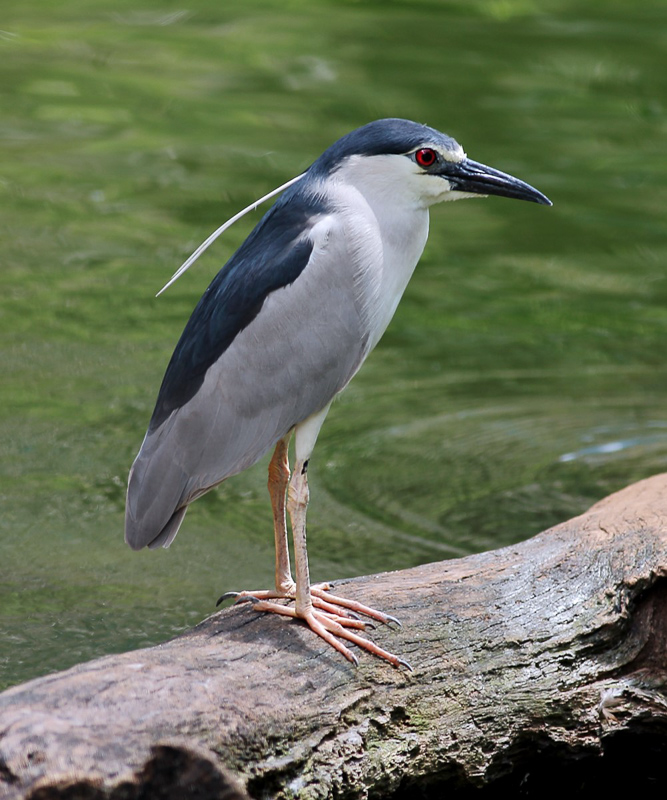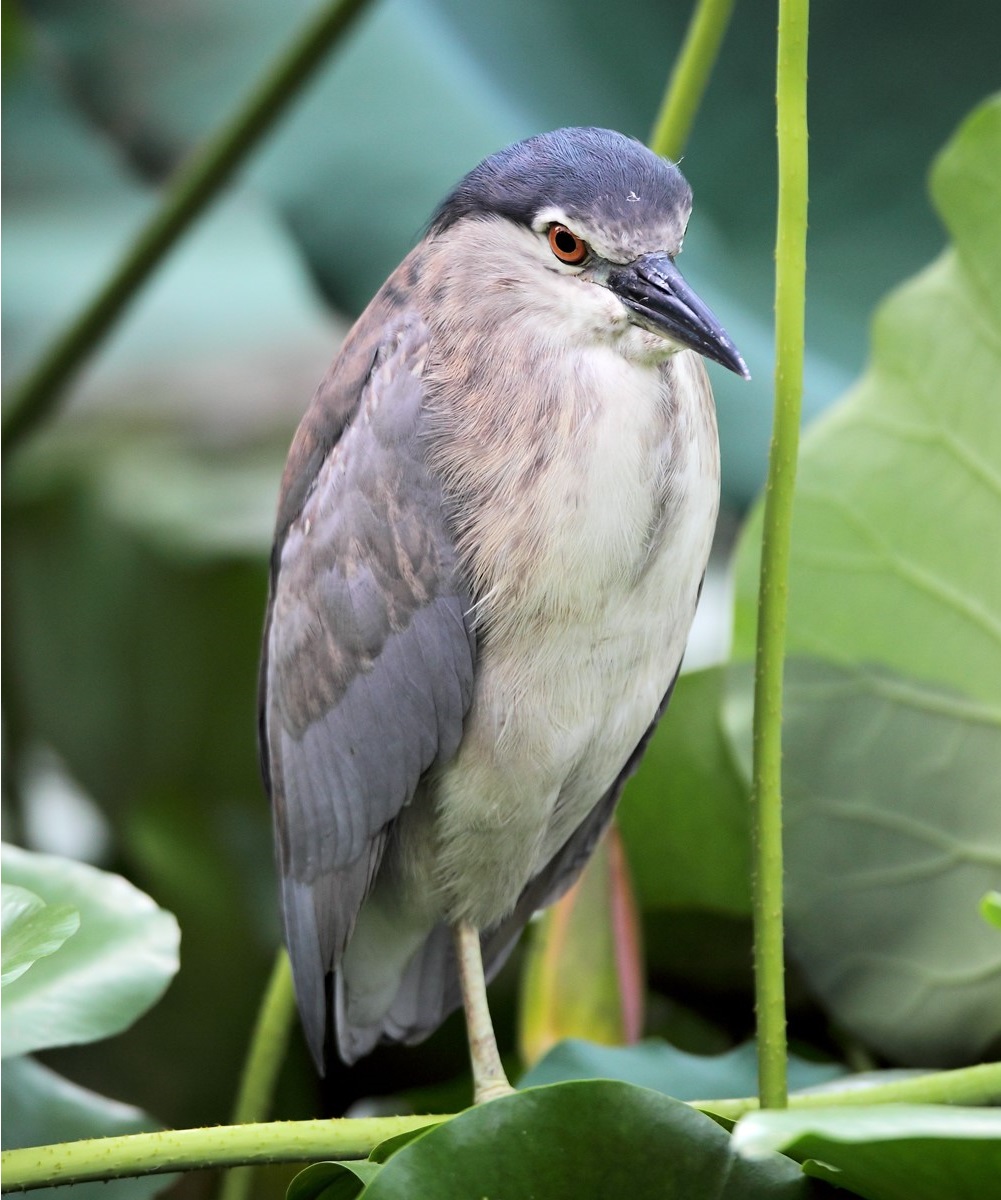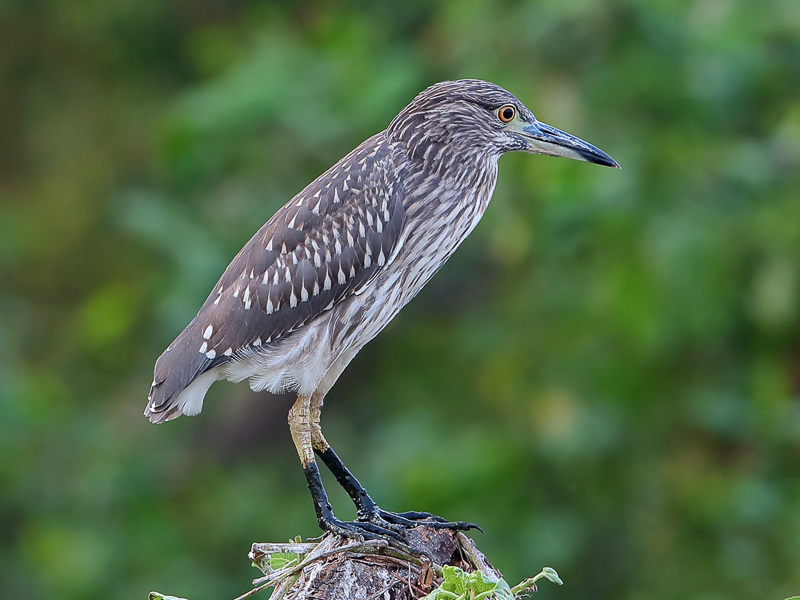Black-crowned Night Heron Nycticorax nycticorax 夜鷺
Category I. Abundant passage migrant and winter visitor and uncommon breeding species. Occurs in variety of wetland habitats throughout HK.
IDENTIFICATION

Jul. 2008, Michelle and Peter Wong. Adult.
58-66 cm. Squat, medium-sized heron with a short bill that is held pointing downward in flight; outside the breeding season usually seen at dusk when birds leave roost to fly to foraging areas or in early morning when migrant flocks search for roost sites. Sexes alike.
Adult has dark grey crown (contrasting with white forehead), nape and mantle and grey underparts and wings.

May 2011, Michelle and Peter Wong.
Second-year birds are similar to adults, but crown and mantle are grey-brown and underparts not pure grey.

Jan. 2022, Paul Leader. Adult.
Adult in flight has plain grey upperwings and pale underwing coverts.

Aug. 2019, Michelle and Peter Wong. First calendar-year.
Birds in their first year are brown with extensive large spots on upperparts and streaked underparts.
VOCALISATIONS
The classic call is an interrogative ‘kwok’ or variants of this uttered when leaving or returning to the roost or on nocturnal migration.
DISTRIBUTION & HABITAT PREFERENCE
Occurs throughout HK in a variety of wetland or wetland-edge habitats. Highest numbers occur in the Deep Bay area, with the largest roosts occurring in the mangroves; smaller roosts occur in undisturbed trees and bushes around inactive fish ponds. Forages in freshwater marsh, fresh and brackish water fish ponds, calm coastal waters and natural and man-made watercourses. Large roosts also occur in other mangrove areas such as those on Lantau.
Black-crowned Night Heron forages in both open wetland habitats such as fish ponds, drainage channels and both man-made and natural rocky shores, as well as in more vegetated habitats such as the edge of mangrove and in freshwater marsh. Appears to shy away from narrow watercourses in shrubland or forest except at the edge.
OCCURRENCE
Although Swinhoe (1861) described Black-crowned Night Herons as nesting in some numbers at Guangzhou, and Kershaw (1904) and Vaughan and Jones (1913) described it as a common resident along the Guangdong coast, the first mention of its occurrence in HK is that of Herklots (1941) who stated that while it certainly bred, it was ‘apparently much commoner in winter’. In addition, he quoted records from Cheung Chau as indicating it was also a passage migrant. Macfarlane and Macdonald (1960) also stated that the species was a passage migrant but that there were also breeding records. However, at approximately one per year, the number of records submitted to the HKBWS during the 1960s was somewhat lower than might be expected, and the peak count at this time was 70 in Deep Bay on 26 December 1967. Most other records were of just one or two birds, and there were no breeding reports.
Numbers increased significantly during the course of the 1970s, such that in 1976 a peak count of 300 was made at Mai Po during 5-6 April and at Mong Tseng on 24 October, with 241 at Mai Po on 8 October 1978. Subsequently, the number present has generally been at least as high, and generally higher, though quite how much of this is due to increased observer activity and reporting is unclear.
During the ten years up to 1978 there was a paucity of winter records; however, by 1 January 1980 the number of wintering Night Herons had increased to 200 birds in the Mai Po mangroves. The number of records continued to increase during the period 1978-1987, with most in spring (33%) and autumn (33%), and fewer in summer (15%) and winter (19%). Peak counts in spring and autumn were 250 at Yim Tso Ha on 28 May 1983 and 400 at Mai Po mangroves on 9 October 1982.
In the period since 1988 the records submitted occurred throughout the year. The highest spring count away from Starling Inlet (where many breed) is 150 at Tsim Bei Tsui in March 1995, while that in autumn is 500 at Mai Po in November 1992. The winter high was of a count of 2,500 at Tsim Bei Tsui on 21 January 1996, which remains the highest so far recorded.
The winter waterbird counts (Figure 1) generally under-estimate the number of Night Herons as they are nocturnal and roost diurnally in dense vegetation in undisturbed areas. In addition, the pattern during the course of the year is influenced by the greater visibility of birds during daytime in the breeding season.
During monitoring of nocturnal autumn migration using a static audio recorder at Pak Sha O, Sai Kung from 2017 to 2021, this was the most numerous species, passing through between mid-August and mid-November.
BREEDING
Herklots (1953) reported that Night Herons bred at the Hang Ha Po egretry, but by the mid-1960s the colony has been abandoned (Macdonald and Macfarlane 1966, Herklots 1967). The next breeding records were not until the 1970s when birds were observed at the Yim Tso Ha Egretry, Starling Inlet in 1971 and at the Mai Po Egretry in 1977. Subsequently, breeding activity was recorded at Yim Tso Ha, the outer mangroves at Mai Po, Mai Po Village, Hebe Haven, Ho Chung and Shuen Wan, and the number of breeding pairs grew. The largest summer population was found around Starling Inlet, with a peak of 300 to 500 birds in 1983. Figure 2 illustrates the number of breeding pairs surveyed annually since 1998 and indicates that most birds breed away from Deep Bay (at Starling Inlet) and highest numbers were present during 1999-2002.
The nesting period appears to be earlier than other ardeids, with recently fledged young reported from the sheltered breeding site in Kowloon Park on 27 April.
BEHAVIOUR, FORAGING & DIET
Generally, forages solitarily. Outside the breeding season most birds leave the diurnal roost from around 15 minutes before sunset to up to 15 minutes after; return after foraging is much more extended and can occur well before sunrise. Usually seen flying to foraging areas at dusk or when returning at dawn; migrant flocks can be obvious early morning at Mai Po NR as they search for roost sites. Seen more often in daytime during the breeding season. Frequently calls in flight throughout the night, though much less so in the daytime. Appears to be the commonest nocturnal migrant ardeid passing through HK.
RANGE & SYSTEMATICS
The most widespread heron globally, breeding on every continent except Australia and Antarctica. Across Eurasia it is generally not found north of 55oN in Europe, southwest and central Asia and China (away from desert and plateau areas). Northerly populations are migratory, and both resident/year-round and wintering populations occur in sub-Saharan Africa, across the Indian subcontinent, Indochina and south China south to Indonesia (Hothem et al. 2020).
Four subspecies are recognised of which the nominate occurs throughout Eurasia south to Indonesia and Africa, including HK. The remaining three subspecies occur in the Americas, including Hawaii.
CONSERVATION STATUS
IUCN: Least Concern. Population trend decreasing.
Figure 1.

Figure 2.

Dove, R. S. and H. J. Goodhart (1955). Field observations from the Colony of Hong Kong. Ibis 97: 311-340.
Herklots, G. A. C. (1941). The birds of Hong Kong. Part XXXVI. Family Ardeidae. (The herons, egrets and bitterns). Hong Kong Naturalist 10: 137-147.
Herklots, G. A. C. (1953). Hong Kong Birds. South China Morning Post, Hong Kong.
Herklots, G. A. C. (1967). Hong Kong Birds (2nd ed.). South China Morning Post, Hong Kong.
Hothem, R. L., B. E. Brussee, W. E. Davis Jr., A. Martínez-Vilalta, A. Motis, and G. M. Kirwan (2020). Black-crowned Night-Heron (Nycticorax nycticorax), version 1.0. In Birds of the World (S. M. Billerman, Editor). Cornell Lab of Ornithology, Ithaca, NY, USA. https://doi.org/10.2173/bow.bcnher.01
Kershaw. J. C. (1904). List of birds of the Quangtung Coast, China. Ibis 1904: 235-248.
Macfarlane, A. M. and A. D. Macdonald (1960). An Annotated Check-list of the Birds of Hong Kong. Hong Kong Bird Watching Society, Hong Kong.
Macfarlane, A. M. and A.D. Macdonald, revised by Caunter, J. R. L. and A. M. Macfarlane (1966). An Annotated Check-list of the Birds of Hong Kong. Hong Kong Bird Watching Society, Hong Kong.
Swinhoe, R. (1861). Notes on the ornithology of Hong Kong, Macao and Canton, made during the latter end of February, March, April and the beginning of May 1860. Ibis 1861: 23-57.
Vaughan, R. E. and K. H. Jones (1913). The birds of Hong Kong, Macao and the West River or Si Kiang in South-East China, with special reference to their nidification and seasonal movements. Ibis 1913: 17-76, 163-201, 351-384.

